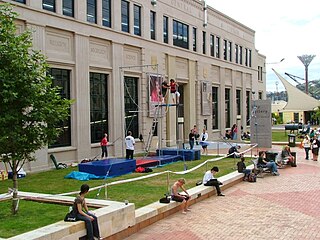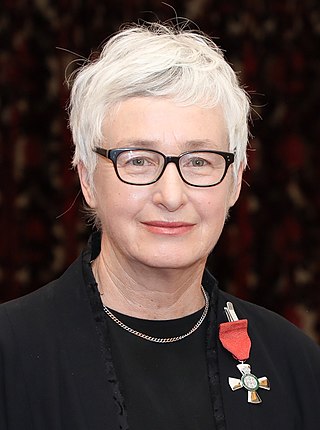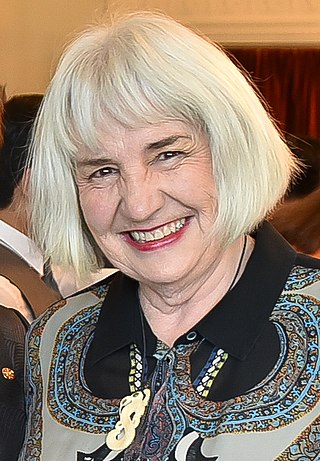Related Research Articles

Annie Collins is a film editor from New Zealand, best known for her work on The Return of the King. She was a film conformer on The Fellowship of the Ring, and moved up to assistant editor on The Two Towers. Her work with Jamie Selkirk helped earn The Return of the King an Oscar for Best Editing in 2004.

Auckland Art Gallery Toi o Tāmaki is the principal public gallery in Auckland, New Zealand. It has the most extensive collection of national and international art in New Zealand and frequently hosts travelling international exhibitions.
Shona Rapira Davies is a sculptor and painter of Ngātiwai ki Aotea tribal descent. Currently residing in Wellington New Zealand.

Alexis Jan Atthill Hunter was a New Zealand painter and photographer, who used feminist theory in her work. She lived and worked in London UK, and Beaurainville France. Hunter was also a member of the Stuckism collective. Her archive and artistic legacy is now administered by the Alexis Hunter Trust.

City GalleryTe Whare Toi is a public art gallery in Wellington, New Zealand.

Kura Te Waru Rewiri is a New Zealand artist, academic and educator. Art historian Deidre Brown described her as "one of Aotearoa, New Zealand's most celebrated Māori women artists."

Feminism in New Zealand is a series of actions and a philosophy to advance rights for women in New Zealand. This can be seen to have taken place through parliament and legislation, and also by actions and role modelling by significant women and groups of people throughout New Zealand's history. The women's suffrage movement in New Zealand succeeded in 1893 when New Zealand became the first nation where all women were awarded the right to vote. New Zealand was also the first country in the world in which the five highest offices of power were held by women, which occurred between March 2005 and August 2006, with Queen Elizabeth II, Governor-General Silvia Cartwright, Prime Minister Helen Clark, Speaker of the New Zealand House of Representatives Margaret Wilson and Chief Justice Sian Elias.

Fiona Dorothy Pardington is a New Zealand artist, her principal medium being photography.

Jacqueline Mary Fahey is a New Zealand painter and writer.

Vivian Isabella Lynn was a New Zealand artist.
Pauline Rhodes is a New Zealand artist. Rhodes is known for her artworks related to the landscape, which take two forms: outdoor works, in which she makes minimal sculptural interventions in the landscape, which exist only through her documentation, and sculptural installations in gallery spaces, which are conceptually related to the outdoor works.
Jacqueline Fraser is a New Zealand artist of Ngāi Tahu descent.

Maureen Robin Lander is a New Zealand weaver, multimedia installation artist and academic. Lander is a well-respected and significant Māori artist who since 1986 has exhibited, photographed, written and taught Māori art. She continues to produce and exhibit work as well as attend residencies and symposia both nationally and internationally.

Christina Joy Barton, known as Tina Barton, is a New Zealand art historian, curator, art writer and editor. She was director of the Adam Art Gallery between 2007 and 2023.
Allie Eagle was a New Zealand artist whose work in the 1970s was key to the development of feminist art practice in New Zealand. She was the subject of the 2004 documentary Allie Eagle and Me. She identified herself as "a lesbian separatist and radical feminist."
This is a timeline of the feminist art movement in New Zealand. It lists important figures, collectives, publications, exhibitions and moments that have contributed to discussion and development of the movement. For the indigenous Māori population, the emergence of the feminist art movement broadly coincided with the emergence of Māori Renaissance.

Kate JasonSmith is a New Zealand actor, film producer, playwright, filmmaker, photographer, and businesswoman. Based in Wellington, she has studied and worked elsewhere, including Australia, Ireland, and the United Kingdom. A feminist, as a theatre and film practitioner, she has been most recognised throughout her career for her role in establishing and producing Hens' Teeth, a platform for dozens of Kiwi female actors, musicians, and comedians that became a staple of the New Zealand theatre and comedy scene between 1988 and 1996. Her short film, Xmas for Lou (1992), won the Best Drama – Television award in the New Zealand Film and Television Awards of 1994. From 2018 on, the one-woman show I'll Tell You This for Nothing: My Mother the War Hero has received national and international praise for both the play, which she wrote, and her performance. JasonSmith is a member of the New Zealand Society of Authors/Te Puni Kaituhi O Aotearoa.
Diane Prince is a painter, weaver, installation art practitioner and set designer and affiliates to the Maori iwi Ngā Puhi and Ngāti Whātua from the north of New Zealand.

Nigel John Floyd Borell is a New Zealand Māori artist, museum curator, and Māori art advocate. He curated the exhibition Toi Tū Toi Ora: Contemporary Māori Art at the Auckland Art Gallery Toi o Tāmaki in 2020, the largest exhibition since they opened. In 2021 the Art Foundation of New Zealand created an award to acknowledge the work of Borrell in this exhibition.
Headlands: Thinking Through New Zealand Art was an exhibition of New Zealand art organised in partnership by the Museum of Contemporary Art (MCA), Sydney and the National Art Gallery, Wellington, in 1992
References
- ↑ "Alter/Image". City Gallery Wellington. Retrieved 25 December 2015.
- ↑ "Mediatrix : new work by seven women artists : an exhibition to mark the centenary of women's suffrage in New Zealand". National Library of New Zealand. Retrieved 25 December 2015.
- ↑ "White Camellias: A Century of Art Making by Canterbury Women". Christchurch Art Gallery. Retrieved 25 December 2015.
- ↑ "Women on women : art in Dunedin since 1893". National Library of New Zealand. Retrieved 25 December 2015.
- ↑ "Exhibition advertisement". Art New Zealand (68): unpaginated. Spring 1993.
- 1 2 3 4 Barton, Tina; Lawler-Dormer, Deborah (1993). Alter/Image: Feminism and Representation in New Zealand Art 1973-1993. Auckland and Wellington: City Gallery Wellington and Auckland Art Gallery. ISBN 0908818149.
- ↑ Barton, Tina (Spring 1993). "Ten years on: Reviewing the terrain for women in art in New Zealand". Art New Zealand (6): 50–52.
- ↑ Zusters, Jane (1994). "Allie Eagle: Artist". Art New Zealand. Summer 1994-95 (73): 53–57.
- ↑ Sayles, Jane (Autumn 1994). "Theoretically speaking: Alter/Image in Suffrage Year". Art New Zealand (70): 49–51.